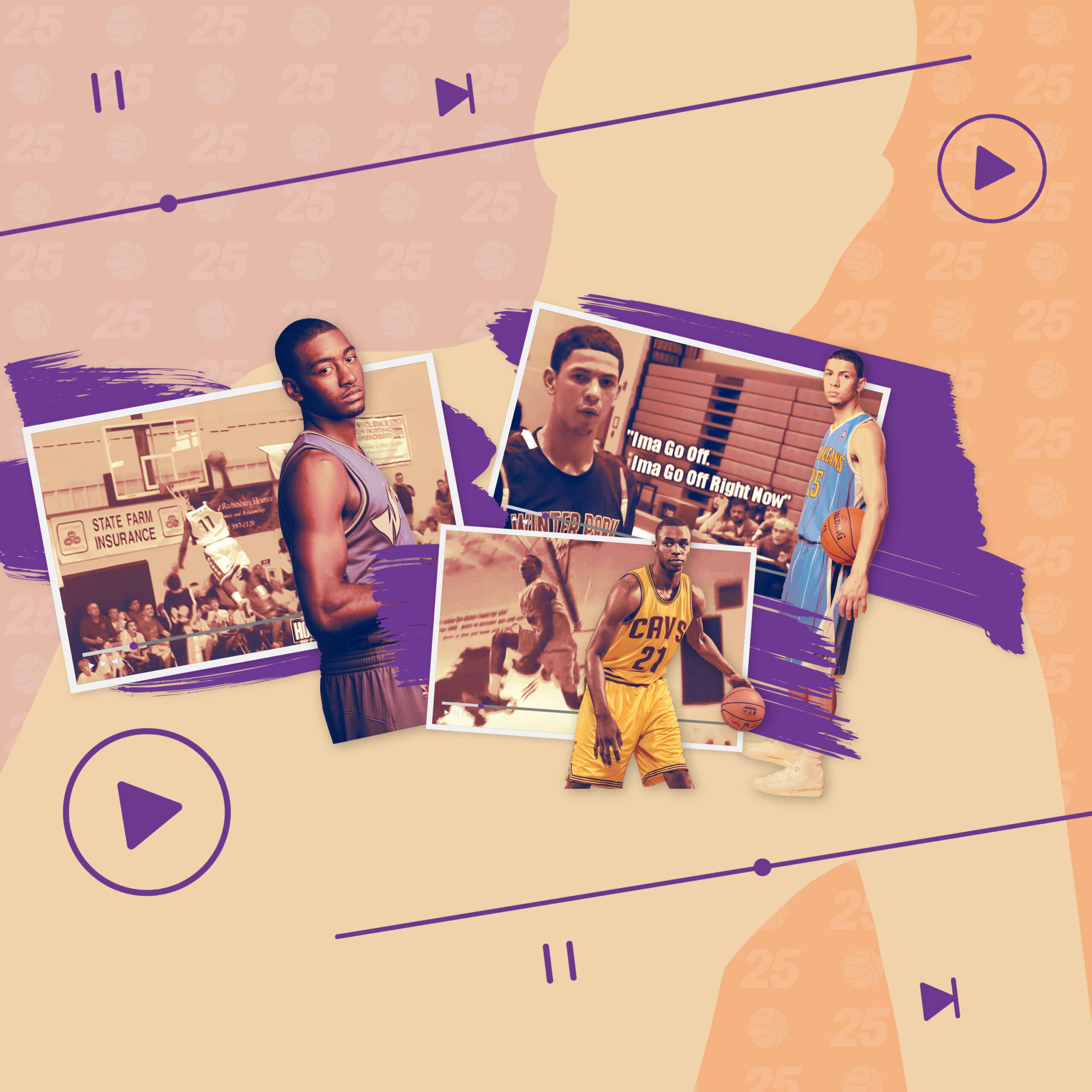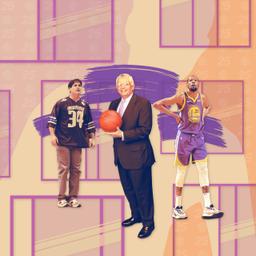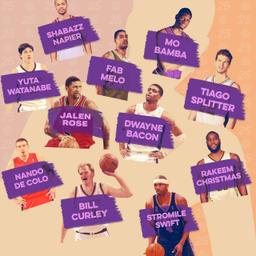
It’s NBA Quarter-Century Week at The Ringer, continuing our site’s yearlong package examining the best of the best—from movie performances to NFL teams to video games—of the past 25 years. This week, we’re focusing on basketball and some of our favorite people and teams lost to time.
On April 23, 2005, a new video-sharing platform called YouTube received its first upload. Almost exactly four years later, John Wall’s official senior-year mixtape was published online. It stands as one of the most important documents in basketball internet history. The electricity generated from that four-minute clip would power a burgeoning cottage industry, a viral pipeline that sold hope to basketball fans at all levels of the game.
The high school mixtape’s golden age spanned roughly a decade, starting at the tail end of the late aughts. It wasn’t a novel, spontaneous concept but a continuation of form. Dig deep enough into the YouTube coffers, and you might be able to find an NBA highlight mix by Yinka Dare—one of the early masters of the form—of Pistons-era Corliss Williamson set to Jurassic 5’s “What’s Golden.” (It doesn’t exist; it should.) But even before the introduction of these highlight videos, legendary skateboarding compilations like “Hokus Pokus” from the late ’80s into the ’90s, anime music videos of Dragon Ball Z clips set to Linkin Park singles, AND1 mixtapes exploring the rhythmic synergy of street basketball, and New York City hip-hop were all born of the same creative impulse. These were audio and visual documentaries spurred on by advancements in technology, built to celebrate a moment in time. These were artifacts that captured a feeling. The promise of the high school mixtape was a slight mutation: These weren’t celebrations of the past. They were early transmissions from the future.
Hoopmixtape, Ballislife, and the like brought that vision to the prep school and AAU circuit, where they captured footage of would-be, could-be stars. The grassroots ethos of it all—hoopheads turned videographers traveling city to city, state to state, mining for enough moments to stitch together a minute-long reel—democratized the glory of the And1 era. It’s human to be on the lookout for what’s next; it’s human to try in vain to capture fleeting moments of awe. What followed was a hype machine that overloaded its own system, producing more than what could be sustained. For every success story, there are hundreds of ghosts lining YouTube’s suggested videos column, clips of teenagers with hyperbolic, comparison-laden titles that are now unthinkable with even a few years of hindsight.
The hoop mixtape isn’t dead. Far from it. But it now exists within a more robust ecosystem that feels, in a way, like a direct response to the unchecked legend-building that early mixtape hype fed into. Video podcast appearances, possession-by-possession game archives, comprehensive scouting breakdowns—all attempt to paint a more detailed picture of these young avatars on the hardwood. There is more access to footage than ever, more data to sift through than ever. Mixtapes used to have the power to become kingmakers through the power of myth. They’ve since eased into the more sensible and logical role of a theatrical trailer. And who among us isn’t a sucker for a good trailer?
Tell me your most cherished high school mixtape, and I’ll tell you who you are. I’m not sure highlights get much better than 5-foot-6 Aquille Carr high-pointing a two-handed chasedown block against a center more than a foot taller than him. “The Crime Stopper” had an iconic mixtape that would have fit right into And1’s peak years. In high school, Zion Williamson was built like Myles Garrett and throwing down 360 in-game windmills. Yet, adjusted for competition, his Duke highlights are somehow even more astounding than what he put up at Spartanburg. That, along with Williamson’s emergence at the tail end of the mixtape era’s heyday, slides him into honorable mentions territory for this exercise. (May also be referred to as the LaMelo Ball Corollary.) There has always been a rich, nostalgic quality to Brandon Jennings’s mixtape, his game so clearly indebted to slight scoring guards of his childhood like Allen Iverson and Nick Van Exel. He was the West Coast’s answer to New York’s Sebastian Telfair hype, half a decade later.
The mixtape I hold most dear never crossed that million-view threshold; I treasure it all the same. Exactly four months after Wall’s iconic video was uploaded in 2009, Hoopmixtape published a highlight reel of a 6-foot-10 17-year-old named Perry Jones lighting it up at an AAU tournament in Las Vegas. Tomahawk dunk after tomahawk dunk; instantaneous elevation off one or two feet; a crossover into a spin move, evading three defenders en route to a layup. The teenager was one of the best athletes I’ve ever seen at that size.
His mixtape was an inspiration—the buzz I got from Jones’s video inspired me to start blogging about basketball in the first place. I followed his up-and-down NCAA career at Baylor; I watched as he landed in the hands of the player development gods in Oklahoma City with the 28th pick in the 2012 draft. He had a streak of brilliance in his short NBA tenure—a three-game stretch at the start of the 2014-15 season, rising to the occasion with both Kevin Durant and Russell Westbrook injured, when he averaged 22.7 points and five rebounds, shooting 52.2 percent from the field and 41.2 percent from 3. He suffered a knee injury that ended that run—on my birthday, of all days. The momentum he’d generated died then and there. That was his final season in the NBA. I’d be lying if I said I don’t think about him sometimes. I revisited the mixtape recently. Every bit as good as I remembered. Still, I laughed when I realized it was only 100 seconds long. Don’t underestimate the power of a chance encounter, however brief. It might stick with you for the rest of your life.
We watched these mixtapes with a willful naivete. We watched for a promise of a better tomorrow. What came next—what the future actually had in store—was beside the point. You can’t tell the story of the past quarter century of basketball without the rise of the high school mixtape. For better and worse, it has become the bedrock for how a generation (and generations to come) sees the game. Everyone has their pet favorites, but there are a handful that serve as standard-bearers, for one reason or another.
John Wall, 2009
The definitive classic, with nearly 11 million views as evidence.
Wall’s mixtape arrived at the tail end of Derrick Rose’s and Russell Westbrook’s rookie campaigns, which frames Wall’s potential neatly. He was the emergent scion amid this growing anticipation for a radical era of nontraditional point guards who bent the game to their will through sheer athleticism. But where Rose and Westbrook exploded like rocket ships pointed skyward, Wall’s explosiveness was more malleable, expressed across all planes. He could throw down a fully extended windmill dunk with the best of them, sure, but his speed and evasive body control could also turn a fast break into something that looked like high-octane parkour. Two minutes and 40 seconds into the video, Wall splits two defenders with what can be described only as a pinball-bumper dribble, loses possession of the ball, and barely regains control before launching himself directly into a 360 scoop layup. He played with the imagination of a kid who got his basketball gifts from a genie, granting him a one-beat, two-beat, three-beat head start on his defender.
He’d go on to become stronger and more balanced on his drives at Kentucky and into the NBA, but even in his senior year at Word of God, he already had a level of self-possession as a run-jump athlete that players can go entire careers without reaching. It’s a timeless video made all the more iconic when you know what kind of movement it’d galvanize.
Austin Rivers, 2011
“I’ma go off. I’ma go off right now.”
Salute to our former colleague. This was a mixtape befitting the consensus no. 2 recruit in the nation in 2011, behind only Anthony Davis (who practically underwent an overnight super-soldier transformation to become one of the best NBA prospects of the millennium). The Gladiator sound bite, the youthful arrogance on display, Rivers’s snappy, skittering hesitation crossovers syncing with the drumbeat—the mixtape itself is well-constructed.
The Rivers hypothesis was fairly clear, even in a three-and-a-half-minute video: What if Jamal Crawford could throw down windmills? That’s a classic Create-a-Player template (see also: Jalen Green, etc.) come to life. It was easy to buy into that kind of hype. Rivers’s game as a youngster reveals an interesting stylistic through line between past and future; the Iverson-inflected ambition of the early 2000s informs his stepbacks, a skill that would become vital in the later 2010s and beyond. There were certainly off-kilter elements to his skill set. His shooting mechanics weren’t the most economical; his crossovers were blink-and-miss but didn’t consistently generate much separation or driving space (which critically affected his ceiling at the next levels). But the quirks added to his mystique; he was an aspirational figure. You wanted to work on your first-step explosion after watching his Hoopmixtape. His game was emblematic of youth culture in that in-between era, not unlike how LaMelo has become a Gen Z messiah. It sounds preposterous more than a decade later, but Austin Rivers was for the children.
Andrew Wiggins, 2013
This was the mixtape era’s Jordan acolyte. The hype around Wiggins back then was insurmountable; Maple Jordan wasn’t a nickname given in jest. The 2012 Nike Peach Jam tournament matchup that pitted Wiggins and then no. 1–ranked 2013 recruit Julius Randle against each other was legendary. Fans were turned away at the entrance, with the crowd overflowing capacity more than an hour before tip-off. Randle had long been considered the best player in his class. Wiggins, newly reclassified, stole the mantle immediately. He had Randle questioning his future for the first time in his life. “Man, I gotta learn how to shoot the ball,” Randle recalled thinking after the tournament on an episode of Podcast P. “Wiggs—he probably don’t even know that, but he was the one that pushed me.” In the moment, it felt like LeBron James over Lenny Cooke at the 2001 ABCD Camp, one decade earlier. It felt like the unofficial anointing of a legend in the making.
Wiggins’s run-jump athleticism at his age was absolutely breathtaking. There are dunk contest–winning throwdowns interspersed throughout this official senior-year mixtape, including a double two-handed windmill that would have ended Dominique Wilkins’s career if Wiggins could transport back to All-Star Weekend in 1990. The mixtape as a form has inherent limitations—there is no room for nuance when every clip is a bold declarative statement, full stop. Wiggins’s head-at-the-rim bounce made him a perfect muse.
Seventh Woods, 2013
Hoopmixtape’s most watched YouTube video of all time also unfortunately serves as a shark-jump moment for the mixtape era. “Seventh Woods Is The BEST 14 Year Old in the Country!” will forever live in infamy. At what point does prospecting for gold do irrevocable harm to the landscape?
But the hyperbole wasn’t completely unwarranted. Woods, as a 14-year-old freshman, already had the build of Blue Devils–era Jay Williams, with full access to an unprecedented level of athleticism for his age. On one play, not one minute into the video, Woods times his block on a fast-break layup. The offensive player is landing on his jump before Woods is done ascending; Woods extends both arms out, swiping at the ball first with his right hand, then with his left. He blocks the ball twice in midair before even beginning his descent to the ground. That isn’t normal! Dig for early clips of your favorite athlete—they probably weren’t jumping out of the gym until at least 16. Growth spurts do a number on the body; growing pains, especially in the knees, are very real. It isn’t until those physical inhibitors go away that a player’s true powers reveal themselves.
Woods being that explosive that young was a promising indicator, but it wasn’t a guarantee of future success. Player development is never linear, and players who are reliant on their physical tools early on are often the ones lagging behind when more technically skilled younger players find their wings a few years later. The mixtape is a reminder of just how heavy the weight of expectations can get. Not all prodigies reach the mountaintop, but for two and a half minutes, we get to revisit an unbelievable ascent.
Thon Maker, 2014
One of the newest features in The Ringer’s most recent NBA draft guide is the Comp Cloud, a visual guide of player comparisons meant to give an outline of a player’s style or arc of development. (What other draft guide is comparing Sixers guard VJ Edgecombe to “Kentavious Caldwell-Pope bitten by a radioactive spider”?) Perhaps we should have called the Comp Cloud the “Thon Matrix.” Comparisons are an integral part of greasing the wheels of intrigue in prospect evaluation. Still, Maker’s hype cycle was unique. And it blew out of proportion almost instantly. On February 7, 2014, CityLeagueHoopsTV published its Thon Maker mixtape, labeling him a “REVOLUTIONARY 7 FOOTER.” The next day, a newspaper headline read, “This Basketball Recruit Looks Like a 7-Foot Kevin Durant-Chris Paul Combo.” When Maker’s prep school coach was asked about his makeup as a player, he was no less hyperbolic.
“I always think he has KG’s competitiveness,” Maker’s Orangeville Prep coach Larry Blunt said. “I think he has LeBron’s poise, where he’s not up and down. He’s always kind of even-keeled. I think he has Dirk’s kind of skill with the size and skill ratio. I just think he’s a hybrid or a combination of so many different players, and that’s what makes him so unique.”
The mixtape arrived nearly two years before Durant brought “unicorn” into the popular basketball vernacular after dubbing then-rookie Kristaps Porzingis as such in 2016; it was published nearly 10 years before Victor Wembanyama entered the league and asserted himself as the concept’s logical end point. In 2014, there were no precepts for evaluating a 7-foot center with point guard ambitions. We watched Maker fluidly transition into crossovers out of spin moves and thought that we were witnessing the future of the sport. And to be fair, we were. Right idea, wrong vessel. Still, those two minutes of footage and that viral round of word association? Thrilling. What a time to be alive. What a time to be a believer.








